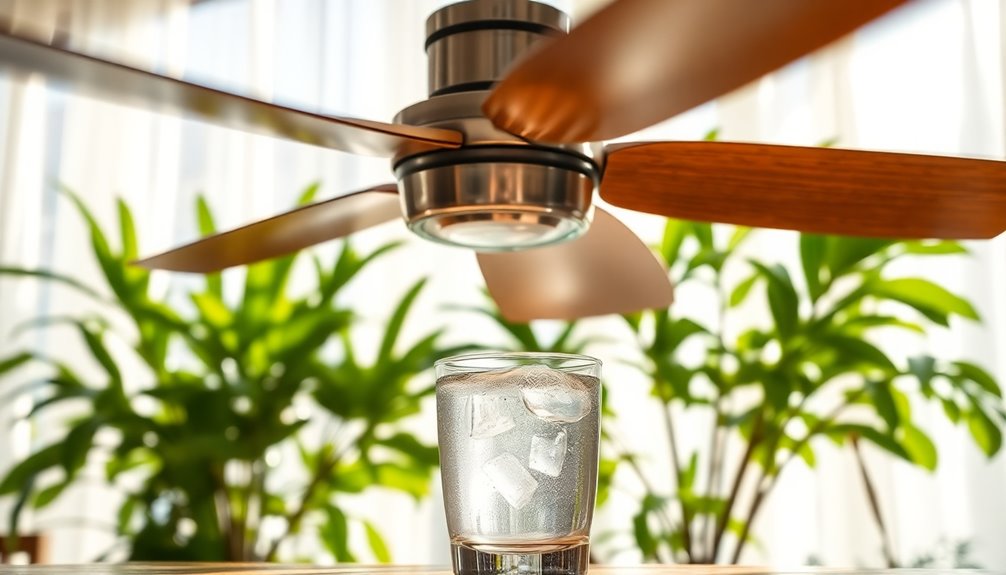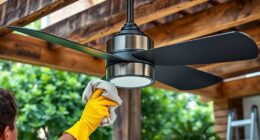A ceiling fan usually pulls between 0.2 to 1.2 amps, depending on its size and design. Standard models, like the 1200mm three-blade fans, typically draw about 0.3 to 0.4 amps, while larger fans may pull up to 0.7 amps. For energy efficiency, you might consider ENERGY STAR-rated fans, which use less power. Remember that startup amperage can be higher—up to three times the running amperage. By understanding these figures, you can better manage your energy consumption. Curious about tips to maximize efficiency or the importance of proper wiring? There's plenty more to explore.
Key Takeaways
- Standard ceiling fans typically draw between 0.2 to 6 amps, with the average being around 0.5 amps.
- A 1200mm three-blade fan consumes approximately 0.3 to 0.4 amps, equating to 35-50 watts.
- Larger ceiling fans, like 1300mm models, may pull between 0.7 to 1.2 amps, consuming 78-140 watts.
- Smart ceiling fans designed for energy efficiency usually draw only 0.2 to 0.3 amps, or 28-35 watts.
- Fans have higher startup amperage, often 2-3 times their running amperage, impacting circuit load management.
Overview of Ceiling Fan Amperage

When it comes to ceiling fan amperage, understanding how much current these appliances pull can help you manage energy consumption effectively. Most standard ceiling fans typically draw between 0.2 to 6 amps, with an average of around 0.5 amps during efficient operation.
If you're using a 1200mm three-blade ceiling fan, expect it to consume about 35-50 watts, translating to a current draw of around 0.3-0.4 amps.
For those interested in energy efficiency, consider opting for ENERGY STAR rated ceiling fans, which use between 28-52 watts and pull approximately 0.2-0.4 amps.
However, if you have a larger ceiling fan with a 1300mm blade span, be prepared for higher consumption, ranging from 78-140 watts and an amperage draw of 0.7-1.2 amps.
It's also essential to note that the startup amperage can be considerably higher than the running amperage. During startup, some fans may draw up to 1.25 amps, while they usually run at about 0.5 amps.
Keeping these factors in mind can help you optimize your fan speed and energy use.
Amperage by Fan Size and Type

Understanding a ceiling fan's size and type is essential for determining its amperage draw. Different fans operate at varying levels of efficiency, which directly affects their amps usage.
For instance, a 1200mm three-blade ceiling fan typically pulls between 0.3 to 0.4 amps, consuming around 35-50 watts. On the other hand, a standard ceiling fan usually runs at about 0.6 to 0.8 amps, with power consumption ranging from 75 to 100 watts when operating at 120V.
If you're considering low-profile or bladeless fans, you'll find they generally use 0.3 to 0.5 amps, translating to a power consumption of 40 to 60 watts.
Smart ceiling fans, designed for energy efficiency, pull only 0.2 to 0.3 amps and consume around 28 to 35 watts.
Larger ceiling fans, like those measuring 1400mm, may draw slightly more, typically around 0.5 to 0.7 amps, requiring 60 to 85 watts for operation.
Keeping these figures in mind helps you choose the right ceiling fan for your space while managing energy consumption effectively.
Electrical Definitions and Calculations

To understand how many amps a ceiling fan pulls, it's crucial to grasp key electrical units like amps, watts, and volts.
You'll use the formula Amps = Watts ÷ Volts to calculate current draw, which is critical for ensuring your fan operates efficiently.
Key Electrical Units
Electricity operates through key units that help you gauge power consumption and circuit design. Two fundamental units you need to understand are amps and watts. Amps, or amperes, measure the flow of electric current in a circuit. The higher the amps, the greater the power consumption by devices like ceiling fans.
To calculate the amps a device draws, you can use the formula: Amps = Watts ÷ Volts. This equation allows you to determine the current draw of ceiling fans based on their wattage and the circuit's voltage. For instance, a typical ceiling fan might draw around 0.5 amps at 120 volts, which translates to an average power consumption of about 60 watts on high speed.
If you're considering energy-efficient options, some ceiling fans, especially those rated by ENERGY STAR®, may use as little as 0.4 amps, corresponding to 48-52 watts.
Understanding the relationship between these units is vital. It guarantees you design circuits properly and avoid overloads in your home's electrical system, keeping everything running smoothly and safely.
Amps, Watts, Volts
Power consumption in electrical devices, including ceiling fans, hinges on three key units: amps, watts, and volts. Amps measure the flow of electric current. When it comes to ceiling fans, they typically draw between 0.2 to 1.5 amps, depending on their size and type.
Energy-efficient models, like those with the ENERGY STAR® label, can operate at just 0.2 to 0.4 amps, providing effective airflow without consuming excessive power.
Watts represent the total power a device uses. To understand how amps relate to watts, it's essential to know the voltage of your circuit. For example, a ceiling fan using 60 watts on a standard 120-volt circuit would draw 0.5 amps (calculated as 60W ÷ 120V = 0.5A).
Keep in mind that startup amperage can be higher than running amperage. Some fans might need up to 1.25 amps when they first start, but this decreases to their normal running draw once they're up to speed.
Formulas for Calculations
When calculating the amperage of a ceiling fan, it's essential to use the correct formula to guarantee accurate results. The formula you'll need is:
Amps = Watts ÷ Volts
In most cases, the voltage supply is 120V in the U.S. For instance, if your ceiling fan consumes 70 watts of power, you can calculate the amperage like this:
70W ÷ 120V = 0.58 amps.
It's important to remember that the startup amperage can be notably higher, often 2-3 times greater than the running amperage.
Here's a quick reference table to help visualize the calculations:
| Watts of Power | Calculated Amps (at 120V) |
|---|---|
| 70W | 0.58 amps |
| 150W | 1.25 amps |
| 300W | 2.50 amps |
| 600W | 5.00 amps |
Always sum the total amperage of devices on a circuit and confirm it doesn't exceed 80% of its rated capacity to maintain safe operation. This way, you can enjoy your ceiling fan without worries!
Startup vs. Running Amperage

Many people don't realize that a ceiling fan's amperage can vary greatly between startup and running conditions. When you first turn on your ceiling fan, it draws a notably higher startup amperage, often 2 to 3 times greater than its running amperage.
For instance, a fan that typically runs at about 0.5 amps may require around 1.25 amps during startup. This surge in power can lead to startup wattage reaching up to 150 watts, compared to its usual running wattage of 70 watts.
Standard ceiling fans usually have running amperage ranging from 0.2 to 1.2 amps, depending on their design and size. Energy-efficient fans, like ENERGY STAR® models, are even better, averaging around 0.4 amps.
Understanding the difference between startup and running amperage is essential for confirming your electrical system can handle the demand without risking circuit overload. If you're planning to install or use a ceiling fan, be mindful of these amperage differences to guarantee a smooth operation and avoid any electrical issues.
Energy Saving Tips

Understanding the differences in amperage can help you make informed choices about energy savings when using ceiling fans. One effective way to save energy is by raising your thermostat by 4°F while using your ceiling fans. This simple adjustment enhances cooling comfort and reduces your reliance on air conditioning, leading to significant energy savings. Additionally, using energy-efficient appliances can further lower your overall energy consumption.
Choosing ENERGY STAR® rated ceiling fans is another smart move. These models use as little as 7 watts, resulting in a 40% reduction in energy consumption compared to conventional fans. Smart home devices can also enhance the functionality of your ceiling fans by allowing you to control them remotely or set schedules for optimal use. Furthermore, utilizing advanced technology in your home can improve overall energy management.
To optimize efficiency further, make sure to regularly clean your fan blades. Dust buildup can hinder airflow, causing your fan to consume more energy than necessary. Regular maintenance practices, like cleaning, can be beneficial for ensuring optimal performance.
Consider using larger blade fans, as they provide effective air circulation without excessive energy use, allowing for lower velocity cooling.
Finally, don't forget to turn off your ceiling fans when you're not in the room. Even efficient fans draw power when running without occupants, so turning them off is a simple yet effective way to conserve energy. Additionally, maintaining air quality considerations can also contribute to overall energy efficiency in your home.
Wiring and Load Management

When setting up your ceiling fans, you'll want to pay close attention to wire gauge and circuit load calculations to guarantee safety and efficiency.
Using the right gauge wire and adhering to breaker capacity guidelines can prevent issues down the line. Additionally, understanding heat transfer principles can help in optimizing the performance of your ceiling fan system.
Let's explore how to manage your wiring effectively for peak performance.
Wire Gauge Recommendations
For ideal safety and performance, selecting the right wire gauge for ceiling fans is vital. Generally, 14-gauge wire works well for a standard 15 amp circuit. If you plan to add extra lighting fixtures, consider upgrading to 12-gauge wire. This guarantees you stay within the safe limits of the circuit while maintaining peak performance.
Remember, you can typically connect up to 12 devices to a 15 amp circuit, but it's important to not exceed 80% of the circuit's capacity, especially under continuous load conditions. Each 60W light fixture draws about 0.5 amps, so keep an eye on the total wattage to guarantee safe circuit management.
If you're installing multiple ceiling fans, make sure to use separate hot wires for each fan if you're using multiple controllers. You can, however, share a single neutral wire among them.
Proper wire sizing is vital for safety; using conductors rated for the expected amperage guarantees efficient operation and compliance with electrical codes. By choosing the correct wire gauge, you'll enhance the safety and functionality of your ceiling fan circuit.
Circuit Load Calculations
Calculating circuit load is vital for guaranteeing your ceiling fan and other fixtures operate safely and efficiently. A typical ceiling fan draws about 0.3 to 1.2 amps, with standard models averaging around 0.5 amps.
To manage your circuit load effectively, remember that the total amperage from the ceiling fans and any additional fixtures shouldn't exceed 80% of the circuit's capacity. For a 15-amp circuit, that means you should keep your total load below 12 amps.
When you're calculating load, don't forget that each standard light fixture also consumes approximately 0.5 amps. This makes precise calculations essential to avoid circuit overload.
The National Electrical Code (NEC) recommends keeping dedicated circuits for ceiling fans below 7.5 amps to guarantee safe operation and compliance with regulations.
You can combine multiple ceiling fans on a single circuit, but make certain the total amperage stays within the circuit's rated capacity. For instance, you can connect up to nine low-wattage fans on a 15-amp circuit.
Breaker Safety Guidelines
Guaranteeing that your ceiling fan operates safely involves adhering to important breaker safety guidelines.
First, understand that a standard ceiling fan typically draws between 0.2 to 1.2 amps, with most residential models averaging around 0.5 amps. When you're connecting multiple fans, remember that the total load on a 15 amp circuit shouldn't exceed 12 amps. This means you can safely run about 10 ceiling fans if each draws 0.5 amps.
For continuous loads, like ceiling fans running for long periods, aim to keep the load below 80% of the circuit's capacity. So, for a 15 amp circuit, that translates to 12 amps maximum.
While breakers can handle short overloads, consistent overloading can lead to circuit failure or fire hazards. Local electrical codes often dictate the maximum devices on a circuit, so it's wise to keep the load below 7.5 amps for dedicated ceiling fan circuits.
Frequently Asked Questions
How Many Ceiling Fans Can Be on a 15 Amp Circuit?
When you're planning to install ceiling fans on a 15 amp circuit, it's essential to take into account the total load.
You could technically run several fans, especially energy-efficient ones, but it's safer to limit it to 2 or 3 fans along with any other fixtures.
This way, you avoid overloading the circuit and guarantee everything operates smoothly.
Always double-check your calculations to keep your home safe and efficient.
How Many Amps Will a Ceiling Fan Draw?
When you're considering a ceiling fan, you'll find that it typically draws between 0.5 and 1.2 amps, depending on the size and model.
Most standard fans consume around 0.6 to 0.8 amps at 120V.
If you go for an Energy Star rated fan, you might only use about 0.4 amps.
Just remember, the startup amperage can spike, so it's wise to account for that when planning your electrical load.
Does a Ceiling Fan Need a Dedicated Circuit?
Imagine a symphony of airflow in your room; that's what a ceiling fan brings.
You don't need a dedicated circuit for it, as it usually fits comfortably within a standard 15-amp circuit.
However, if you're planning to run multiple fans or heavy lighting, it's wise to contemplate a dedicated circuit.
This way, you're ensuring your fan's performance remains smooth, like a well-conducted orchestra, without any interruptions or tripped breakers.
How Many Amps Does an Attic Fan Draw?
When you're considering an attic fan, you'll find that it typically draws between 0.5 to 3 amps, depending on its size and motor type.
Most standard models operate around 100 to 300 watts, translating to about 0.83 to 2.5 amps at 120 volts.
If you choose an energy-efficient fan, it could use as little as 0.5 amps.
Always check the manufacturer's specifications to guarantee you know the exact amperage for your specific model.
Conclusion
To sum up, understanding how many amps your ceiling fan pulls is like knowing how much fuel your car needs for the journey ahead. By grasping the differences in amperage based on size and type, you can make informed choices that keep your energy bill in check. Remember, energy efficiency isn't just about the fan; it's about how you manage your home's electrical load. So, take charge and enjoy a breezy, cost-effective environment!









